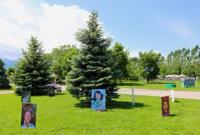You are here
Nature of Almaty.

Tours in nature of Almaty.
“What is history? An echo of the past in the future. Reflection cast by the future on the past.
Victor Hugo.
Natural sights of Almaty.
The city of Alma-Ata is located at the foot of the northern slope of the Zailiysky Alatau, at an altitude of 750 - 850 meters above sea level. According to its relief, the Alma-Ata region is a sloping territory with an average rise of 3-4% in the direction from north to south.
Moreover, as you move south, the rise increases somewhat and already 3 - 4 kilometers from the city is replaced by sloping hills, which are called "counters". They come close to the city from the east side. In the south and southwest, snowy mountain peaks rise like a huge wall above the city, which create an amazingly beautiful backdrop for the city.
The nature of the terrain determines the direction of the street network and petitioning canals. All city streets have latitudinal and meridional directions. The territory of the city itself is limited by the channels of the Bolshaya and Malaya Almatinka rivers, the beginning of the ascent to the "counters" and the line of the Tashkent alley.
The Malaya Almatinka River flows in the eastern part of the city, and the Vesnovka River flows in the western part. From these rivers, a system of ditches is supplied with water, which serves to irrigate urban lands.
In the southern part of the city, the Head Ditch originates from the Malaya Almatinka River, which runs along Arychnaya Street. The entire irrigation system of the city is fed from the Head Ditch, giving life to its green spaces.
The whole city is buried in the greenery of orchards, mighty elms, slender pyramidal poplars and sprawling oaks. Apple orchards surrounding the city from almost all sides, in the south they are connected with the virgin forests of the foothills of the Zailiysky Alatau.
The geological structure of the city territory is represented by the alluvial fan of the Bolshaya and Malaya Almatinka rivers, which is composed of alluvial deposits - river boulders, pebbles, sands and loams. In the lower part of the cone, in the area of the Tashkent alley, there is a more homogeneous and fine alluvium, which imperceptibly passes into loess-like loams to the north.
Higher to the south, the cone is composed of larger and mixed particles. The thickness of the alluvial fan in different parts of the city is different. The thickness of silty loams in the central part of the city fluctuates from 1 to 3 meters, then there are denser soils - boulders and pebbles.
Usually the foundations of buildings are laid on these soils and the pressure on them is taken in the range from 2.5 to 4.5 kg/cm3. In hydrogeological terms, the territory of the city is characterized by a deep occurrence of groundwater, which makes it possible to build basements outside their sphere of influence.
Storm and ditch waters falling into the northern part of the city create swampy areas here. The Alma-Ata region belongs to the first category of seismic regions, corresponding to 9 points. Studies have established that earthquakes here are of tectonic origin, i.e. they are caused by an imbalance in the layers of the earth's crust.
It was found that not all areas of the city are equally affected by the earthquake. The greatest destructive effect occurs where the terrain changes dramatically and where the strata of alluvial deposits are replaced.
The high risk of an earthquake is the most unfavorable natural condition for construction in Alma-Ata. Naturally, it is reflected in the external appearance of the city, both in the past and at the present time. The predominance of small one-story wooden buildings in the building of the city in pre-revolutionary times, located at a considerable distance from each other, was due to the high seismicity of the area.
Only in Soviet times, large three-four-storey buildings appeared here, built of reinforced concrete, wooden frame and burnt bricks in compliance with the technical conditions provided for by the instructions for anti-seismic construction.
One of the important features of the seismic of the Alma-Ata region is landslides and landslides in mountain gorges, which create the danger of the formation of mud and stone flows. Thus, strong earthquakes on May 28, 1887 and December 22, 1910 were accompanied by mudflows.
The mudflow that occurred in 1841 was catastrophic. The mud-stone tray on July 8, 1921 had a formidable character, the cause of which was an unusually warm downpour that caused the rapid melting of snow accumulated on the mountains.
Water washed away from the peaks surrounding mountains a large amount of sand, pebbles and stones, which, sliding down into the gorge and into the riverbed, formed a dam. This accumulated mushy mass of dirt broke through the dam and moved down to the city with great force, destroying everything in its path.
Only the turn of the bulk of the stream to the left - into the bed of the Vesnovka river - saved the city from inevitable death. But still part of the flow reached Alma-Ata; the axis of its movement passed along Karl Marx Street. Until now, in many places of the city there are large blocks of stones brought by this stream.
The Alma-Ata region is distinguished by an exceptionally favorable healthy climate: mild winters, moderately hot summers and warm autumns. High temperatures here are possible only in July and August, when the average daily maximums slightly exceed 30°.
But due to the proximity of the mountains and the presence of night winds blowing from there in summer, there are often cool nights with a temperature of 16 - 17 °.
Geographical coordinates of city of Almaty: N43°14'29.53" E76°55'04.26"
Authority:
Mendikulov M. M. "Architecture of the city of Alma-Ata". Alma-Ata, 1953.
Photos by
Alexander Petrov.







